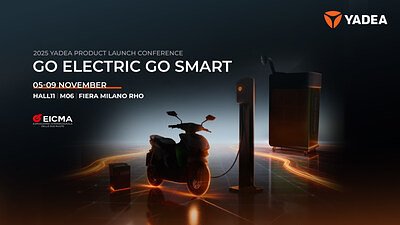
Yadea’s Sodium-Ion Push: Rewriting the EV Ecosystem Beyond Lithium
Yadea unveils a bold vision for electric mobility at EICMA 2025, centering on innovative sodium-ion battery tech, a robust charging ecosystem, and ambitious European expansion. Can this Asian giant disrupt the EV landscape?
Yadea’s Sodium-Ion Push: Rewriting the EV Ecosystem Beyond Lithium
Milan, Italy – November 3, 2025 – Yadea, the eight-time consecutive leader in electric two-wheeler manufacturing, is making waves at EICMA 2025, not just with sleek new models, but with a comprehensive ecosystem designed to tackle the limitations of current electric vehicle infrastructure. Beyond the unveiling of the European-debut Velax e-motorcycle series and a long-range Keeness model, Yadea’s strategy centers on a shift beyond lithium, embracing sodium-ion battery technology and a decentralized charging network. This isn't just about building better scooters; it’s about reimagining how we power our future.
For years, the electric vehicle revolution has been largely dependent on lithium-ion batteries, a technology facing supply chain constraints, environmental concerns, and rising costs. Yadea is betting big on sodium-ion as a viable alternative. Their newly developed Polar Sodium 1 battery, showcased at EICMA, boasts a 100km range, a 1500-cycle lifespan, and impressively fast charging capabilities. While still in its early stages, sodium-ion technology offers a more sustainable and potentially cheaper solution, as sodium is far more abundant than lithium.
“The key isn’t just about extending range; it’s about building a system that’s accessible to everyone, everywhere,” explains a Yadea spokesperson. “Sodium-ion allows us to reduce our reliance on a finite resource and lower the barrier to entry for electric mobility.”
Beyond the Battery: A Holistic Ecosystem
However, Yadea’s vision extends far beyond simply swapping lithium for sodium. The company is aggressively building a comprehensive ecosystem to address the challenges of charging infrastructure, particularly in densely populated urban environments. This includes a 15-second battery-swapping network, designed for efficiency and convenience, and a pioneering solar-charging solution with integrated sodium energy storage.
“One of the biggest hurdles for EV adoption is ‘range anxiety’ and the lack of convenient charging options,” says an industry analyst familiar with Yadea’s strategy. “Battery swapping bypasses the long wait times of traditional charging, and the integration of solar power adds another layer of sustainability.”
The battery swapping network is designed to be scalable, allowing riders to quickly exchange depleted batteries for fully charged ones at designated stations. This approach is particularly attractive in cities where access to home charging is limited. The solar-charging solution, meanwhile, aims to reduce reliance on the grid and provide a clean, renewable energy source for the network.
European Expansion: A Competitive Landscape
While Yadea already holds a dominant position in the Chinese electric two-wheeler market, its European expansion represents a significant challenge. The European market is characterized by fierce competition from established players, stringent regulations, and diverse consumer preferences. However, Yadea appears well-prepared to navigate these complexities.
“Yadea understands that Europe isn’t a one-size-fits-all market,” explains a market research analyst covering the European EV sector. “They’re tailoring their products and marketing strategies to meet the specific needs of each country. The focus on affordability and practicality is a smart move in this price-sensitive market.”
The company is prioritizing key markets like Germany, France, and Italy, offering a range of models designed for urban commuting and leisure. The long-range Keeness model, in particular, is expected to appeal to riders seeking a versatile and efficient transportation option.
However, challenges remain. Navigating EU regulations surrounding vehicle safety and emissions is a complex undertaking. Competing with established European brands like Piaggio and BMW, who have strong brand recognition and extensive distribution networks, will require significant investment and strategic partnerships.
The Sodium-Ion Gamble: A Sustainable Future?
While the long-term viability of sodium-ion technology remains to be seen, Yadea’s commitment to this alternative battery chemistry is a bold and potentially game-changing move. By investing in a more sustainable and readily available resource, the company is positioning itself as a leader in the next generation of electric mobility.
“The biggest advantage of sodium-ion is its environmental profile,” says an independent battery technology expert. “Sodium is abundant, readily available, and doesn't require the same ethically questionable mining practices as lithium. If Yadea can scale up production and maintain performance, they could disrupt the entire battery industry.”
The success of Yadea’s ambitious strategy will depend on a number of factors, including the continued development of sodium-ion technology, the expansion of the charging infrastructure, and the company’s ability to adapt to the unique challenges of the European market. But one thing is clear: Yadea is not simply building scooters; they’re building an ecosystem – one designed to redefine the future of electric mobility.
By embracing sodium-ion technology, building a decentralized charging network, and expanding into new markets, Yadea is sending a clear message: the future of electric mobility is not just about going electric; it’s about doing it sustainably, affordably, and accessibly for everyone.
